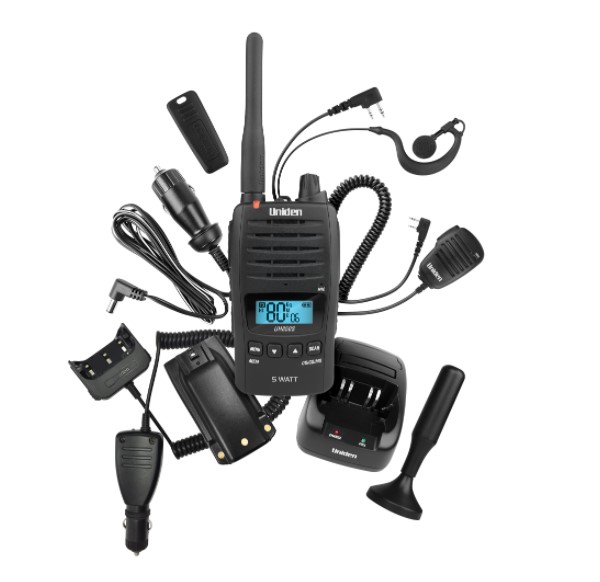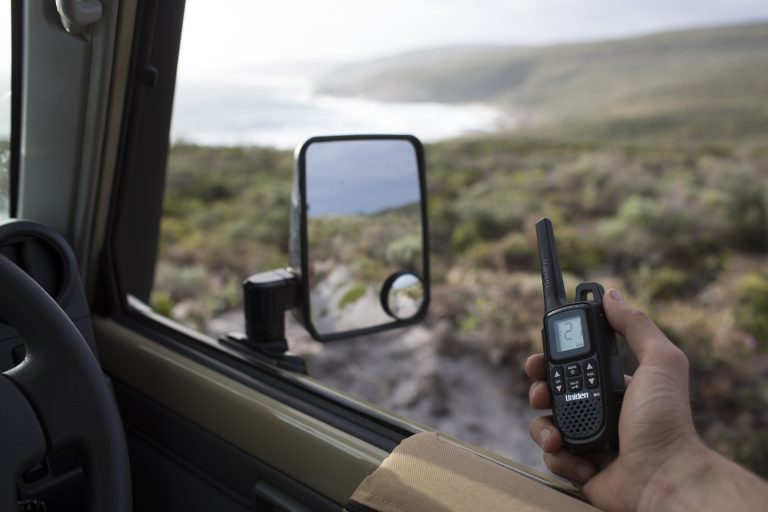A walkie talkie or handheld two-way radio is so much more than a kid’s toy. Mobile phones have done so much for communications, however, having a constant open channel has so many applications, especially for small businesses. This guide will explain what you need to know about a handheld two-way radio and help you make a buying decision.
A walkie talkie, portable CB or two-way is a handheld radio that allows two or more parties to communicate verbally via free radio spectrum. Any party in range on the same channel will hear all transmitted broadcasts. Communication is initiated by pushing a button only whilst talking.
WHY should I buy a two-way radio for my business?
The two-way radio has been around since the Second World War, and it revolutionised our ability to communicate remotely. With no additional infrastructure (like a phone tower), we can quickly and easily communicate with two or more parties.
Common walkie talkie uses for small business include:
- Worksites – to coordinate cranes, vehicles, worksite activities, help required
- Restaurants – co-ordination of meals, empty tables, spills
- Retail outlets – enhancing customer service, stock control, security
- Warehouse – facilitate collection, call back to a dock
- Farm – location identification, voice communication with no phone coverage, lunch call, safety
Unlike a mobile phone, a two-way allows all users to hear the same messages and essentially have a group chat to coordinate activities. Once the walkie talkie is purchased, there are no ongoing monthly charges and is only limited by its range and battery.
WHAT do I need to understand?
A walkie talkie is a handheld device containing a battery, an antenna, microphone, speaker, radio transmitter, and receiver. In Australia, they work on an Ultra High Frequency (UHF). The publicly available models have 80 possible channels (see Channels below).
Range
The radio range is determined by two factors the wattage or transmission power (see next point) and the obstacles between the antennas of each handset. The range will be greater if there is a direct line of sight between the two handsets. Hills, buildings, walls and even trees will reduce the operating range between each handset.
Power/wattage
In Australia, the maximum wattage permitted is 5 watts(w). Generally, a walkie talkie can be bought with 5w, 2w, 1w or 0.5w. Higher wattage models will allow you to switch between different wattage. Reduced wattage gives you reduced range, but longer battery life and more privacy as others are unlikely to be in range to hear your conversation.
How far will my walkie talkie work?
- 5 watts up to 17km
- 2 watts up to 13km
- 1 watt up to 7km
- 0.5 watt up to 3km
Channels
Channels relate to fixed frequencies the radio can operate at. There are 80 channels to select from, but there are some channels you should not use.
General use: 9-21, 24-29, 39, 49-60, 64-70, 79,80. USE THESE ONES
Repeater Channels: 1-8,31-38, 41-48, 71-78. (use repeater stations to increase range)
Emergency use: 5, 30
Caravaners: 18, 20 (generally use)
Truckies: 29, 40
Data (no voice): 22,23
HOW to choose a walkie talkie?
The below features are ones you should consider in making your decision:
Size – how big the unit is and where you will carry it.
Controls – how easy it is to change the channel or increase the volume. Could be a rotary knob or buttons.
Battery life – some cheaper models use disposable batteries, but for work purposes, you should look at a rechargeable lithium battery model. Ensure the unit has a clear battery level indicator. Models should indicate an operating time in hours based on 90% standby, 5% transmit, and 5% receive.
Charging – depending on your situation and power sources available for recharging, you can choose between 240v mains, 12volt car charger or USB charger (not supported by all models).
Durable – some radios are built better than others. Some models are designed to take punishment, including being run over and dropped from a height. Look for die-cast chassis.
Incoming alert – this is similar to a ring tone and helps you recognise incoming communication.
Talk confirmation – a tone that indicates the other party has stopped talking and removed their finger from the transmit button. Saves you from saying “over” to finish speaking.
Scan– allows you to scan other channels to hear any conversations in range. Some models allow you to select which channels to scan.
CTCSS (Continuous Tone Coded Squelch System) & DCS (Digital Coded Squelch) – allows a group to talk to each other without hearing other users on the same channel and delivers clearer channel operation.
Scramble – enables private communications by scrambling the voice signal. This prevents users without descrambler equipment or a compatible unit from understanding the conversation.
Master scan technology – if your current channel is interrupted by outsiders, all radios in your group will automatically jump to a new clear channel allowing uninterrupted communication to continue.
Waterproof – it is unlikely to be fully waterproof. Still, it will survive water immersion to a depth of up to 1 metre for a specified number of minutes. Look for the IP rating. Note this rating is based on brand new units, not battered units with ageing seals. This same rating will indicate it is also dustproof.
Handsfree mode (VOX) – some models will allow voice activation, so you do not even need to press a button to talk.
LED Torch – a built-in LED light.
Backlit screen & keys – great if you will use at night.
Accessories

- Microphone – a spiralled cable attached microphone allows communication without holding 2-way.
- Earpiece – a separate earbud speaker and microphone enable discrete communication
- desktop charger – for convenient charging
- carry case – to protect the walkie talkie
- belt clip – for convenient transport
- 12volt (car) charger – recharging in your car
- spare battery – peace of mind by having a 2nd battery
- external antenna – the stubbie antenna can be unscrewed, and an external magnetic antenna and cable can be attached to increase range from a vehicle
HINTS
Remember, this is a public network, so others can easily eavesdrop on your conversations if they are in range.
Two-way radios permanently mounted in a vehicle don’t need charging and can communicate with walkie talkies, assuming you are in range and on the same channel.
You can licence a channel for commercial purposes, increasing your privacy but also will increase costs.
SUMMARY – Which walkie talkie?
A walkie talkie is a valuable business tool. It can be used to increase productivity and improve customer service. Radio communication comes into its own when several parties need to communicate at no additional cost, especially when there is no mobile phone coverage. More expensive models will have a greater range and the ability to keep your calls private.

2 comments
[…] Guy’s sister publication Small Business Answers has covered this subject in detail. Click this link to understand this technology before visiting your local […]
[…] […]